March to May 1956
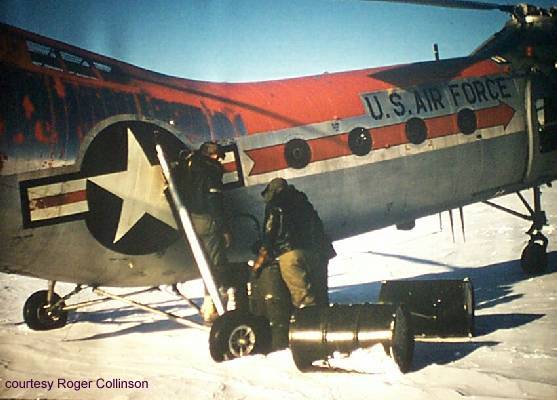
March 1956.
This is Mar., ’56 at the Base camp for Resx-1 (Brevoort Island). Prior to the helicopters arrival a DC-3 had been dispatched with barrels of gas for the chopper. Each barrel held about 25 gallons. The barrels were air dropped near the base camp and when we got there we had to move the chopper to each of the barrels and hand pump the fuel. I do not recall how many barrels there were, but it seemed that after each trip from the base camp to the test site we had to go to a couple of barrels.
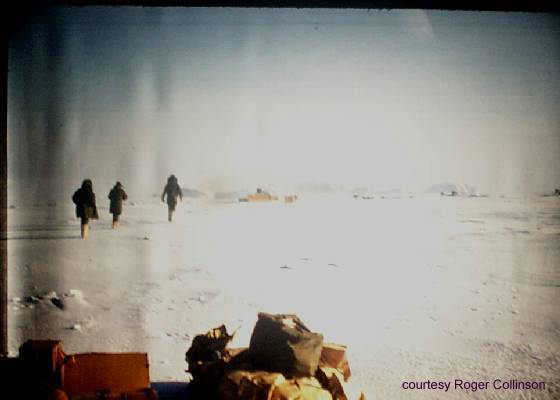
March 1956.
This is one of the first pictures of Resx-1. The crew is walking form the chopper towards the site where the Jamesway hut and tower will be. You can see some of the material that had been brought prior to this picture. It took us nearly two days to transport the material from the base camp (four miles away). the last day we erected the hut and anchored it with 2 X 4s’ buried in the snow about 10 inches. The generator hut was a prefab plywood with canvas cover. We has trouble with the generator because of the heat generated. every couple of days we would have to reposition it as the snow and ice under it kept melting.
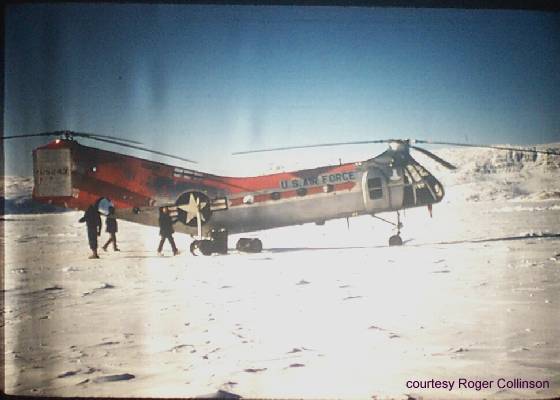
March 1956.
This us preparing to refuel the chopper. We had to roll the barrels through the snow. Luckily the air drop had been in clusters so the barrels were not too far apart. However, rolling a 50 gallon drum half full of gas did take some doing.
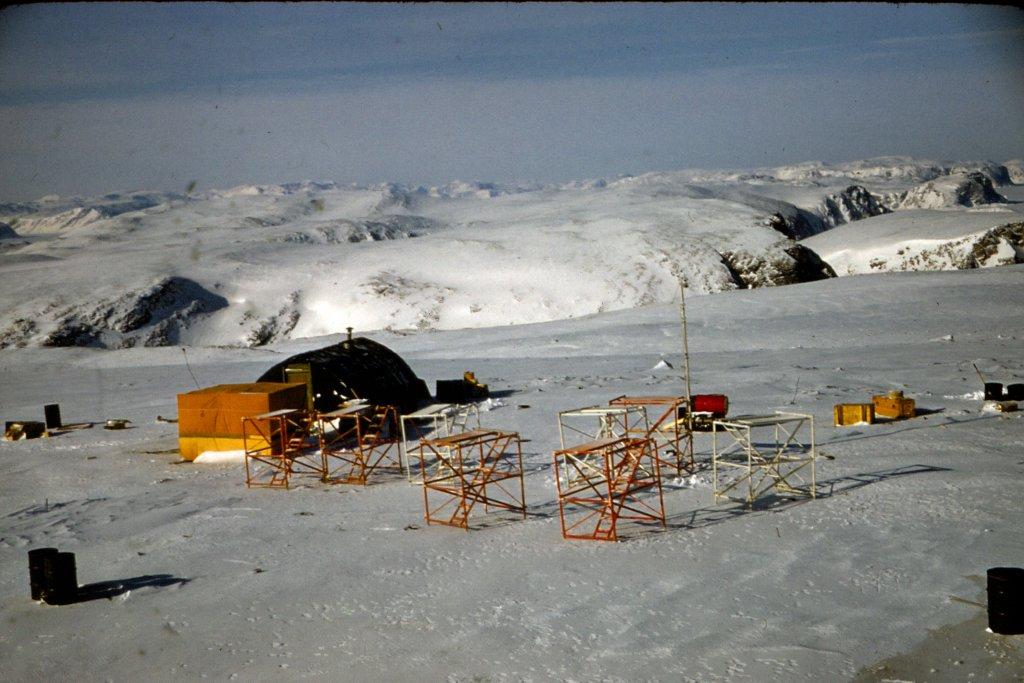
March 1956.
March 1956. Start of the test site at ResX-1. This was the last picture I got of the site. I ran out of film and when I put in a new roll it broke as I closed the camera and I was not aware of it until the middle of May when I was home and couldn’t figure how I was getting 40 pictures on a 36 exposure roll. I found out! I would have had a good picture taken from the rock outcropping I was standing on for this. We had a DC-3 drop out mail, and fresh meat while I stood on this rock and looked DOWN at the plane as it dropped our packages. Oh, well.
As you can see the tower was made up of 8 – 6 ft. sections. These were aluminum tubes connected together with clips. In the back ground in a red 50 gallon drum set on its side on top of two half barrels. The red barrel had a 1 foot square hole on the top to put snow into and a tap on one side to drain melted snow. We poured diesel fuel in the bottom halves and lit it. As the snow melted we carried the water, in a wash tub, to the sixteen barrels making up the anchor for the guy wires. Four barrels at each anchor and the anchor rod imbedded in the ice and showing between the barrels. It took us about 24 hours to fill all of the barrels. Very dirty. Our outer clothes and faces were black with the soot from the fire. Nice job. Jack of all trades. The temperature at the time was in the low teens so the water froze pretty quick. Once the barrels were filled and the anchors set we piled more snow in from the barrels and watered it down to make the anchors a little more solid.
We used a ‘Jin” pole to raise the tower sections in place, attached to the lower section with clip pins, we attached the guys at 12,24,36 and 48 foot intervals on each corner then tensioned them with turn buckles. We had a Tensiometer to even out the tension. We checked the tension twice a week and adjusted if necessary.
The canvas covered hut in front of the Jamesway was our generator and stool. Again, the half barrel with a wooden seat.
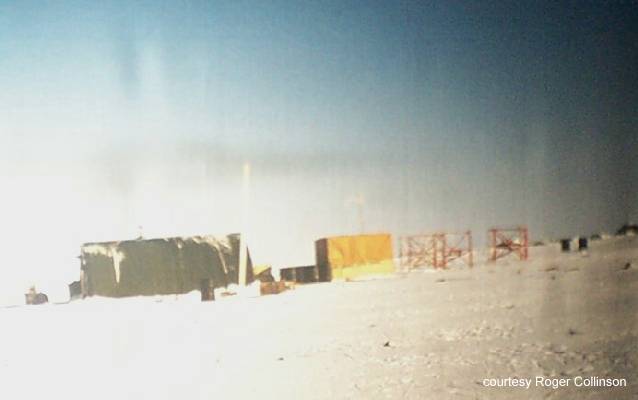
March 1956.
Another view of the site. You can see the tracks of the barrels where we rolled them up to the site. A large crate on the side of the Jamesway held all of our perishable food (bread, eggs, potatoes, bacon, ham, etc.) I took enough food in to last three of us for a month. It ended up feeding 5 of us for over 6 weeks. An aside: did you know that you can freeze eggs. Of course all you can do is scramble them. We would decide the night before what we would eat the next day and bring the food in and place it on a board overhead in the hut to thaw out over night. Potatoes can only be boiled. Bread is no problem. I had a large roll of salami that we repeatedly took in to cut off some to eat with crackers and Canadian Club (a no-no in the area, but I brought it in unseen by the Cramps) Over time I guess the Salami went south and for the last week at the site I had a gut ache that wouldn’t quit.
Once we had the guys tensioned we hoisted the Dish and fastened it to the 2 foot top rail. At the same time we installed the coax cable and attached the communications radio antenna to one corned and strung the wire out to a 10 foot 2X 4 that we had froze in the ice. With everything running we called Cape Dyer and told them that we were ready to begin testing. You ask, “How did I know where to put the dish?” Well, the surveyor, Jack London (real name) had set up a base line and I was given orientation. I paced off the distance from the hut and took a ‘gauged by eye’ towards Dye. I had a latitude of plus or minus 40 degrees in which to swing the dish. We had a EE-8 Field Telephone (ala Radars radio on Mash) for communications between the top of the tower and the hut. The person in the hut would observe the Esterline Angus Recorder for a signal and tell the man on top to start swinging the dish from left to right in 5 degrees increments. Each move would last about 5 minutes once we detected a signal. Once we had the best signal the transmitter end would do the same thing. When the horizontal alignment was complete we would do the same vertically. Our expected path loss was computed to be around minus 95 dbm. After our line up we were getting minus 105 to minus 110 dbm. This didn’t make New York happy. They informed me that they would ship out a ‘Threshold Extension Panel’ to depress the noise level so we would get a better signal. this was shipped to the base camp and the site supervisor and head mechanic walked it in to us. We installed it and the signal improved by 5 db!.
We lucked out during the construction of the site and the alignment. Nice, cold, clear weather. A week later a storm hit us. I estimated the wind to be blowing in the 60 – 70 MPH range. We had a rope tied between the hut and the generator hut, even though it was only about 15 -20 feet. The blowing snow made it a virtual ‘Whiteout’. We even had to go to the lavatory for no. 1. Otherwise we got a face full! The wind was so bad that the wall of the Jamesway on the storm side was pushed in and the canvas/asbestos insulation was like a brick wall. The opposite wall had space between the support ribs and the covering that you almost walk through. The first morning after the storm hit John Cole woke up and complained of the cold. I looked across the hut and he had a pile of snow under his cot. We got rid of the snow and found a small pin hole in the canvas that was allowing the snow in.
We had a 35,000 BTU heater in the hut, but the wind sucked the heat out. We fashioned a duct using empty food cans with both ends off and soldered together to pick up the cold air off of the floor and direct into the control flue of the heater. This helped, but the temperature at waist level was 32 degrees for the duration of the the storm (one week). We wore our Arctic gear 24 hours a day, even in our sleeping bags. it was a little uncomfortable to say the least.
Things settled down after the storm. We did have a beautiful picture one morning. A low cloud cover came in during the night and it was full of water (mist, etc.) and it deposited a three inch film of soft hoar ice on the tower. When the sun crept up the sight was unbelievable. I took my camera for a picture, but you know what had happened to the film. Too bad!.
One morning I woke up to hear John Cole laughing followed by a noise like something being dragged across ice. Upon emerging from the hut I saw that John had constructed a sled using a large piece of plywood with a small piece of 2 X 4 nailed across the front and a rope attached. He was sliding the hill behind the hut. It was about 100 yards long and at a good angle. We spent most of the day sledding. Doesn’t take much to amuse people. I think that the hill bottom is where the permanent airstrip was to be built.
One day we noticed that the test signal was wiping a red blotch clear across the recorder paper, instead of a signal varying line. I noted this on my daily report to headquarters. This went on for several days. The engineers had planes fly out over the test path to see if they could spot anything. Nothing but a patch of open sea water was found. The problem cleared up and the test went on.
In the 3rd week of April I was informed that a 2 man Geodetic team was coming to shoot the stars for an accurate placing of the site. I laid out the original base line as Jack Londons marks had faded. the chopper arrived at 2 P.M. and the team stepped out. Two brothers from Toronto. Both over 6 feet tall. They had their bed rolls and cots, just in case. they told the pilot that if it was a clear night that they would be ready for pickup the next morning. The night was ideal and they finished shooting at 4 A.M.. I radioed the base camp to telex Frobisher for the chopper. Message came back -“Chopper is out of service, prospects two days”. This went on for over a week.
Finally, our tests were completed and we started to pack up the gear and we all waited for the Chopper. At this time I was having stomach pains that wouldn’t quit. I could only keep hot tea and saltines down. I notified the New York office that I wanted a complete physical upon my return to civilization.
Still no transportation. On May 2, 1956, I radioed the base camp to alert Frobisher that we were walking out as the food (what little there was) had been depleted and there was less than a half barrel of fuel for the generator and heater.
We left at 7 A.M. (first light) starting down the hill. The two brothers decided to slide down the hill in their Arctic gear (regular Army foul weather gear). Away they went . they shouted back to the rest of us to do the same. I decided to do it. it seemed easier than trying to walk down with MukLuks, etc.. The only thing I forgot was that I had on the U.S.A.F. Nylon covered flying pants and parka. Once I pushed off I WENT!! I have never had a ride like that. I zipped past the brothers and dodging rocks, I slide about 50 yards further onto the level ground. It sure save a lot of steps, and gave the gang a good laugh. I was covered in snow from digging in my feet trying to stop. The level ground was O.K., but it had about 2 feet of soft snow that we had to trudge through. In my condition I didn’t know if I could make it. The gang kept with me and made sure that I didn’t fall down.
We arrived at the base camp at about 1:30 P.M.. Immediately we went to the mess hall to check on some food. the cook told us they had just finished a Turkey dinner and there was plenty left. We got plates and piled it on. Went to a table and all 5 of us started to cry. We couldn’t eat. We nibbled. I guess we were all close to a starvation point. We did get some food and coffee down. I went to the radio operator and asked if any of the planes coming in had seats for us. The first plane said he had jump seats in the back. I took him up on it, even though the Big Bosses had told us not to ride in cargo planes. We wanted to get out, and we did.
Upon arrival at Frobisher we got sleeping quarters, bedding, towels and we hit the showers for a long hot, clean bath. The bunks were elevated (about 2 feet off the floor) and in the morning I couldn’t get out of bed. My crotch was sooo sore!! I guess the high stepping through the snow and my weakened condition. I managed to roll out and crawl, then stand. All of us were in the same shape. I think I was the worst.
Guess what. the next day the Chopper was ready to go!!! I sent John Cole and Emmet back to get our personal things and close up the site.
I went South. to NYC and the physical. Asked the doctor what could have caused the problem and he said it may have been Ptomaine from eating the Salami that had been thawed and refrozen. Any lasting effects? He said “NO.”
I returned to work, AT&T Long Lines, St. Louis, Mo. towards the end of May. A couple of weeks later I started to have pains in my stomach again. I thought, “No side effects??” I Called my doctor and told him what had happened and he suggested a hospital visit for tests. I arranged to go in on the weekend and came home on Thursday night nearly doubled over. My wife told me to put on my P.J.s and try to relax. I did. A few minutes later I felt better. I told her and she said to put my pants back on, but do not button them. I did, and I noticed that the top of my pants were about 2-3 inches from meeting!! I had been sucking in my gut each time I dressed and did not notice. I stepped on a scale and found that I had gained forty pounds in six weeks that I had been home. The Wife let out my pants and I was healed!!! No hospital.
I often think about the Dew Line job, but do not think that I would do it over, if I had the chance. I regret that I never got back to Fox-5 or Res-X-1 to see the completed site. I did see the Dye sight in 1960 when I was, again, up North, but that is another story.
Roger Collinson, March 8, 2002.
